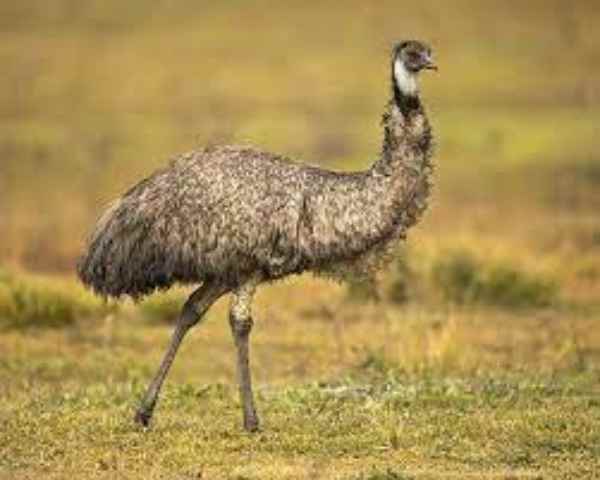Emus, a species of flightless avian existing since prehistoric times, are indigenous to Australia and New Guinea, boasting an impressive maximum height of 6 feet. The query regarding the potential danger posed by emus may arise due to their colossal stature.
Table of Contents
While emus are typically not deemed hazardous to humans, there is a possibility of harm if they perceive a threat or are safeguarding their offspring. Generally speaking, emus are timid creatures that strive to evade human interaction. However, in self-defence, they have been known to employ their robust legs and razor-sharp talons to deliver kicks and scratches.
To minimize any potential issues, it is advisable to grant emus ample space and refrain from approaching them, particularly during their breeding season. This prudent approach serves as the most effective means of preventing possible complications.

When Do Emus Aggressive?
While investigating the behaviour of domesticated emus, researchers observed minimal instances of aggression. These aggressive behaviours were exclusively witnessed in male emus during the breeding season.
The emus under scrutiny were previously recognized for their docile and placid temperament. Nonetheless, during the breeding period, they undergo heightened stress levels, resulting in the display of aggressive conduct.
Conversely, wild emus pose a significantly greater threat compared to their captive counterparts. When faced with being cornered or sensing danger, their innate instinct propels them to retaliate and protect themselves.
Similar to many other animals, emus can exhibit aggression when their offspring are at risk. Male emus, in particular, demonstrate fierce protective instincts towards their chicks, defending them against perceived threats or potential predators, including humans.
In instances of aggression, emus assume an upright posture and inflate their feathers around the neck area, aiming to appear more imposing.
Furthermore, hissing sounds emitted by an emu can serve as an indicator of potential danger and should be noted as a warning sign.

What Makes Emus Dangerous?
The imposing size of emus stands as the primary factor contributing to their potential danger. Reaching heights of up to 6 feet, emus hold the distinction of being the second-largest bird worldwide, surpassed only by their relatives, the ostriches.
This substantial stature grants emus some of the most robust legs in the animal kingdom, capable of serving as formidable weapons. Remarkably, emus are the sole avian species endowed with calf muscles. A forceful kick from their legs, equipped with razor-sharp three-toed claws, possesses the capacity to inflict significant harm upon any living being, even in spite of their typically gentle disposition.
Adding to their potential threat, emus exhibit remarkable swiftness, sprinting at speeds of up to 30 miles per hour. This agility allows them to rapidly close the gap between themselves and perceived threats.
Consequently, knowing how to safely interact with an emu when encountering one face-to-face becomes crucial. Understanding the optimal approach is essential before approaching them too closely.
The key lies in establishing a sense of safety for the emu, minimizing the perception of threat. Kneeling down serves as an effective strategy, as it diminishes your threatening presence. If the emu shows signs of disinterest or attempts to move away, it is vital not to pursue or follow the bird. Doing so could trigger a sense of threat, potentially leading to an aggressive response involving their powerful legs.
By attentively observing their behaviour and respecting their personal space, you can safely appreciate the captivating nature of these creatures from a suitable distance.
Do Emus Attack Humans?

Contrary to popular belief, emus are often misunderstood as aggressive and hostile towards humans, when in reality, they possess a generally calm and gentle nature. Unless provoked, emus are unlikely to engage in attacks against humans.
It is crucial to delve into the context surrounding incidents involving emu aggression to gain a comprehensive understanding. As mentioned, emus primarily exhibit aggression when they feel threatened, especially when safeguarding their offspring or nesting sites. Additionally, human injuries have occurred when individuals have deliberately provoked or disturbed the birds.
While there have been reported cases of wild emus attacking humans, such as a recent incident in Queensland, Australia, where a woman was struck in the head by a wild emu, such occurrences are rare. They typically transpire when humans encroach too closely or engage in inappropriate interactions with the birds.
For instance, attempting to ride an emu, as one individual foolishly did, can lead to severe injuries inflicted by the bird’s powerful claws. However, in the majority of instances, emus will not initiate attacks against humans unless provoked.
To ensure your safety, it is essential to treat these majestic birds with respect and exercise caution when in their presence. By doing so, you can peacefully coexist with emus without provoking any aggressive responses.
Are Emus Dangerous to Livestock?

Farm owners often ponder whether emus can peacefully coexist with other animals, but there is no definitive answer to this question.
Emus are solitary creatures by nature. In the wild, they only form flocks when foraging or migrating, as they are not, particularly social birds.
When considering the integration of emus with livestock, numerous factors come into play. Firstly, emus necessitate large areas to roam, along with secure fencing for their safety.
However, emu chicks raised alongside other animals often develop harmonious relationships and may even form bonds with them. Conversely, introducing new livestock to adult emus can potentially trigger aggressive behaviour, posing a danger. There have been instances where emus have injured or even killed other livestock by stomping on them.
To introduce new animals to emus, including fellow emus, a gradual familiarization process is crucial. It involves keeping them separate until the presence of the newcomers no longer arouses excitement or aggression from the emus.
Emus need time to become acquainted with any new living beings entering their territory, and over time, they tend to accept them. This process demands careful handling and can take several weeks or even months to complete successfully.
FAQs
Do Emus Bite?
Well, the answer is yes, they can and will bite! While emus are generally known for their passive nature and are unlikely to attack humans unprovoked, they can still bite if they feel threatened or uncomfortable in their surroundings.
Can an Emu Kill a Person?
While emus are known for their sharp claws and powerful legs, it’s highly unlikely that they would cause fatal harm to a human. In the rare instances where emus have attacked people, the injuries were usually minor and caused by scratching or pecking.
What Are Emus Scared of?
Well, as it turns out, emus are highly sensitive to sudden movements and loud noises. This means that if you were to run towards an emu or make a loud banging sound near them, they are likely to become startled and take off running. In addition, emus are known to be wary of unfamiliar people and animals, so if you encounter one in the wild, it’s best to give them plenty of space and approach them slowly and calmly.
Final Words
Emus may seem like gentle creatures, and for the most part, they are. These birds have a naturally calm disposition and don’t pose any real threat to humans. But like any animal, emus have a defence mechanism, and they will use it if they feel threatened. This can lead to aggressive behaviour, which may be dangerous for anyone in the vicinity. So if you want to stay safe around these unique creatures, it’s important to avoid any actions that could provoke them. Don’t touch them, corner them, or tamper with their chicks.
Reference:
- https://www.britannica.com/list/6-of-the-worlds-most-dangerous-birds
- https://www.thetimes.co.uk/article/birds-of-a-feather-dont-flock-together-when-ostriches-fancy-humans-pq20jsk75mg
- https://nationalzoo.si.edu/animals/emu
A motivated philosophy graduate and student of wildlife conservation with a deep interest in human-wildlife relationships, including wildlife communication, environmental education, and conservation anthropology. Offers strong interpersonal, research, writing, and creativity skills.










